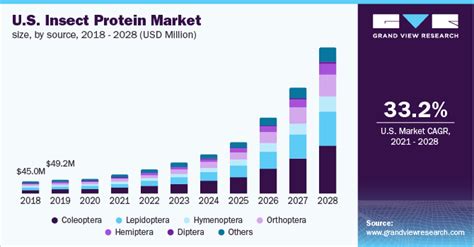Introduction
Entomophagy, the practice of consuming insects as food, is gaining traction as a sustainable and nutritious alternative to traditional protein sources. This article explores the current state of entomophagy and the potential of insect protein to revolutionize the food industry by 2025.

The Rise of Entomophagy
At least 2 billion people worldwide currently consume insects, primarily in Asia, Africa, and Latin America. This practice is driven by factors such as:
- Nutritional Value: Insects are rich in protein, minerals, vitamins, and fiber.
- Environmental Sustainability: Insect farming requires significantly less land, water, and greenhouse gases than traditional livestock production.
- Cultural Acceptance: Entomophagy is deeply rooted in many cultures and is beginning to gain acceptance in Western countries as well.
The Potential of Insect Protein
Insect protein offers numerous advantages over traditional protein sources:
- High Protein Content: Some insects, such as crickets and mealworms, contain over 60% protein by weight.
- Essential Amino Acids: Insects provide all nine essential amino acids needed by the human body.
- Clean and Sustainable: Insect farming produces minimal waste and has a low environmental impact.
- Versatility: Insect protein can be incorporated into various food products, including bars, powders, and processed meats.
Challenges and Opportunities
While entomophagy and insect protein have promising potential, several challenges remain:
- Consumer Acceptance: Overcoming consumer resistance to eating insects is crucial for widespread adoption.
- Regulation: Establishment of clear regulations and standards for insect production and consumption is essential to ensure safety and quality.
- Scalability: Scaling up insect farming to meet the growing demand for insect protein presents operational and cost challenges.
Strategies for Success
To overcome these challenges and unlock the full potential of entomophagy by 2025, stakeholders can:
- Educate Consumers: Raise awareness about the nutritional and environmental benefits of insect protein through campaigns and tastings.
- Innovate Products: Develop innovative food products that incorporate insect protein in flavorful and appealing ways.
- Collaborate on Research: Foster collaboration between researchers, industry, and regulators to advance scientific knowledge and address consumer concerns.
- Encourage Investment: Attract investment in insect farming to increase production capacity and reduce costs.
Pros and Cons of Entomophagy
Pros:
- High nutritional value
- Environmental sustainability
- Cultural acceptance
- Versatility of insect protein
Cons:
- Consumer resistance
- Regulation challenges
- Scalability concerns
Highlights and Standout Strategies
- The global insect protein market is projected to reach $8 billion by 2025.
- Start-ups such as Aspire Food Group and Bugible are developing innovative insect-based food products.
- Governments in Thailand, Vietnam, and the United States are regulating insect production and consumption.
- Consumers are increasingly open to trying insect-based food items, especially in powdered or processed form.
Conclusion
The race to 2025 is on to unlock the full potential of entomophagy and insect protein. By overcoming challenges and leveraging opportunities, stakeholders can transform the food industry and provide a sustainable, nutritious, and environmentally friendly alternative to traditional protein sources. As consumer acceptance grows and innovation continues, insects will likely become an essential part of the global food supply chain in the years to come.
Tables
Table 1: Nutritional Comparison of Insects to Traditional Protein Sources
| Nutrient | Crickets | Mealworms | Beef | Chicken |
|---|---|---|---|---|
| Protein (%) | 62 | 57 | 20 | 21 |
| Fat (%) | 17 | 31 | 15 | 10 |
| Fiber (%) | 5 | 6 | 0 | 0 |
| Iron (mg) | 9 | 7 | 2.6 | 1.4 |
Table 2: Environmental Impact of Insect Farming
| Metric | Insect Farming | Traditional Livestock |
|---|---|---|
| Land Use (kg/kg protein) | 1 | 10 |
| Water Use (L/kg protein) | 50 | 1,000 |
| Greenhouse Gases (kg CO2-eq/kg protein) | 0.5 | 30 |
Table 3: Regulatory Landscape for Entomophagy
| Country | Status |
|—|—|—|
| Thailand | Fully regulated |
| Vietnam | Partially regulated |
| United States | Emerging regulations |
| European Union | Proposed regulations |
| Australia | No specific regulations |
Table 4: Strategies for Overcoming Challenges in Entomophagy
| Challenge | Strategy |
|—|—|—|
| Consumer Resistance | Education, innovative products, tastings |
| Regulation | Collaboration, research, establishment of standards |
| Scalability | Technology, investment, operational efficiency |





















